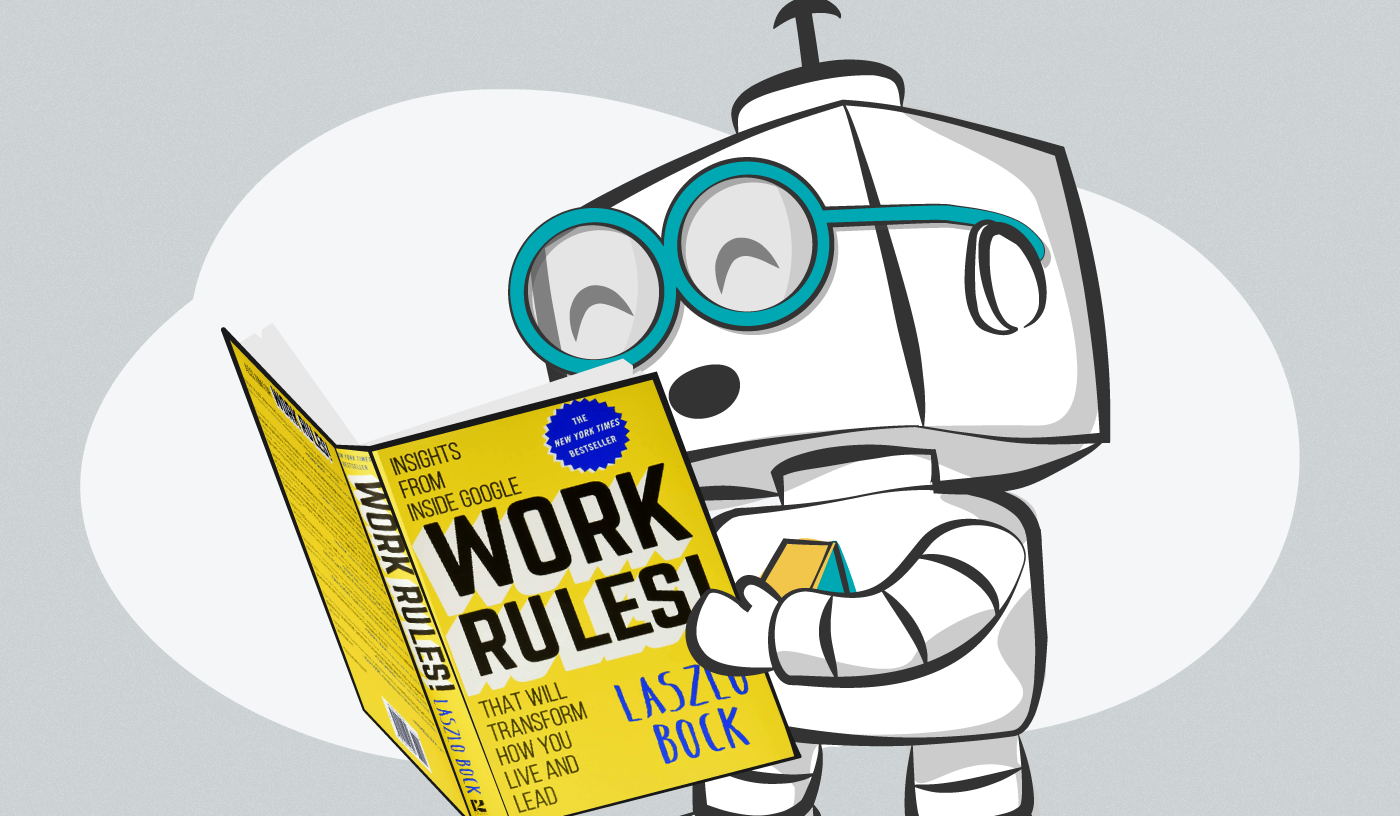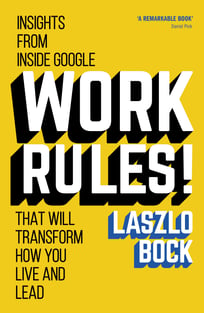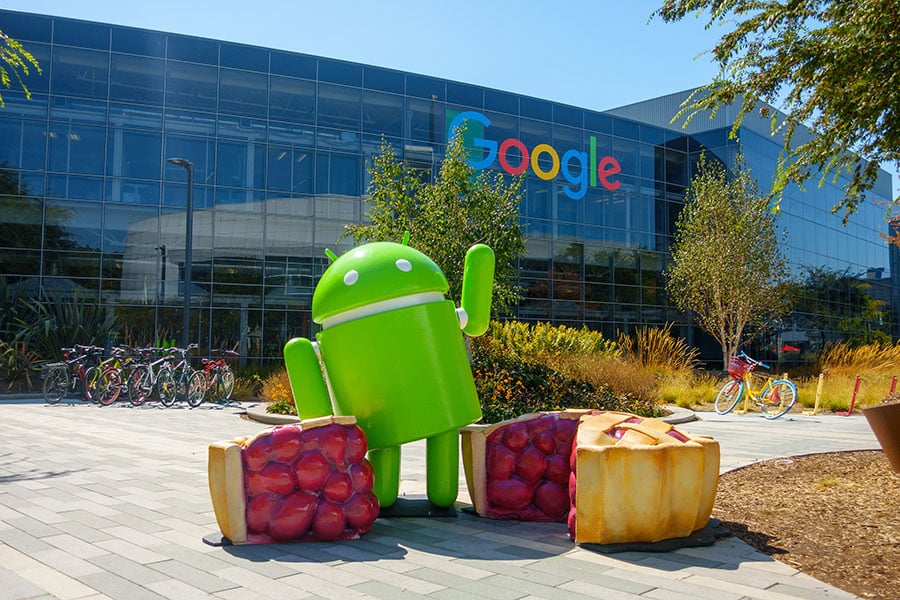MONTHLY NEWSLETTER:
Subscribe and join our community of curious HR Professionals and Managers.
Latest Article
Categories
Quick Links
Applauz Blog
Published: October 26, 2021
Last Updated: November 3, 2022
12 min read
By: Michelle Cadieux

In this edition of Applauz Book Club, we explore the book Work Rules! and what Google can teach us about HR strategy and attracting top talent.
📖Applauz Book Club is a series that outlines noteworthy ideas from popular books on the topics of work, HR strategy, and management. To see last month’s Applauz Book Club article, click here.
"We could never afford the perks that Google offers."
This is the first thought that crosses the mind of many HR professionals when thinking of this powerful tech giant.
As a result, HR teams or leaders may quickly jump to the conclusion that their company culture can never be as great as Google's. This is especially true for small or medium-sized businesses or those managing employees in a less "glamorous" industry, like manufacturing.
But what if this assumption isn't true...
Could your company build a great culture like Google's without a huge budget?
Laszlo Bock, the now-former Head of Google's People Operations, believes anyone can build a great work culture regardless of industry or budget.
His 2017 book Work Rules! reveals why Google is consistently rated one of the best places to work in the world.
Reading the book, it becomes clear that Google's employer brand is a success -- not because of nap pods or gourmet meals. Rather, the "secret" lies in the principles the organization upholds and adheres to at every level of the business.
or gourmet meals. Rather, the "secret" lies in the principles the organization upholds and adheres to at every level of the business.
Bock takes us through a journey and provides readers with concrete recommendations that can be put into practice by any business. So even though you may not have the scale that Google has, you can adapt many of Google's ideas to your business regardless of its size.
That said, as this is a fairly long book, our goal is not to summarize everything. Instead, we want to give you a taste of the book and highlight the most critical points. The focus will be on ideas related to HR practices and other strategies for motivating and engaging employees.
We will discuss key ideas from the following chapters:
Suppose you are more interested in recruiting or hiring. In that case, Work Rules also includes several chapters discussing Google's hiring and recruiting strategies. If you're interested in reading the entire book, find it on Amazon here.
Let's begin!

Culture Eats Strategy for Breakfast
If you asked an average employee at Google to describe the culture, they likely would use the word "fun."
This is natural, as Google has all sorts of programs and practices in place that promote a "fun" atmosphere. Such as celebrating April Fool’s day. But Bock explains, "fun is an outcome of who we are, rather than the defining characteristics."
In other words, "fun" is not a word painted on a wall under "our company values." It is the result of Google’s core beliefs that have been carefully laid out by the company.
As you will see, many of the programs and policies outlined in the book stem from these fundamental principles.
Let's look at each one in a little more detail.
A mission is your company's north star. It keeps employees centred on your "why" and consistently motivated towards the future.
Bock offers Google's mission as an example: "to organize the world's information and make it universally accessible and useful."
So why is Google's mission so motivating?
According to Bock, a great mission gives work meaning. It motivates employees because "it is a moral goal rather than a business goal."
In other words, moral messages speak to human emotions. Just like a great TV commercial, this type of emotional messaging is compelling and inspiring.
On the flip side, a company mission statement centred on a business goal like becoming a "market leader" doesn't speak to employees on a deeper level.
Most importantly, a business goal can always be attained, while a moral mission never ends.
There will always be more information to organize and make useful to the world, Bock explains. That's why mission statements like these are particularly effective in inspiring long-term motivation because they stand the test of time.
Transparency is often cited as a core feature of strong company culture. Still, many companies struggle to become more transparent in their actions.
Bock offers readers insights into this critical component of company culture. He does this by giving examples of how "transparency" is reflected in many of the practices and procedures at Google.
For example:
In short, a transparent organization shares information with its employees, and trust is easily given, regardless of their title or position.
Some leaders might feel skeptical about the notion of giving employees access to all this sensitive information.
But Bock argues, "openness demonstrates to your employee that you believe they are trustworthy and have good judgement." And ultimately, it's simply the "right thing to do," another guiding value he touches on throughout the book.
According to Bock, giving employees a voice means “giving them a real say in how the company is run.” Many of Google’s people practices actually originate from employee feedback.
For example, in 2009, Google’s annual survey revealed employees’ frustration with Google’s bureaucracy. In short, it was becoming harder to get things done.
Rather than announcing a “top-down corporate initiative,” Google’s CFO Patrick Pichette put the power into Googlers hands.
Pichette launched a “Bureaucracy Busters” program. In this annual program, Google employees talk and identify their biggest frustrations with bureaucratic processes like budget approvals.
After the first Bureaucracy Busters session, Google implemented all the changes Googlers asked for. Employees were happier, making it easier for Bock’s People Operations team to do their work. Essentially, it was a win-win.
Bock closes this chapter by saying, “if you give people freedom, they will amaze you.” He advises, “if you’re not nervous, you haven’t given them enough."
Let the Inmates Run the Asylum
For many leaders and managers, the million-dollar question is how to motivate employees and get them to act like owners rather than employees.
According to Google's philosophy, autonomy is essential for happiness and fulfillment at work.
Autonomy means power is shared -- everyone has a voice, regardless of seniority or title.
Google expresses its commitment to this philosophy in many of its practices.
For example:
Yet, Bock explains too many companies operate otherwise -- only letting a few people hold all the power over major decisions.
Bock believes businesses should do the opposite. Leaders should trust employees more and assume the best in people. Because he believes these assumptions have the power to shape the destiny of work culture.
For example, if you assume employees are lazy and out to take advantage of your company, this can give rise to an unbalanced work culture that uses chain of command systems, rules and bureaucracy to control supposed bad behaviour.
In other words, in an effort to control a minority of bad actors, you kill the entrepreneurial and innovative spirit of a company and end up driving away your best people. And of course, this only leaves more of the wrong people behind.
Bock believes giving trust and creating an environment of mass empowerment is vital for motivating high performance. He explains that you have to counteract our human tendency to defer to authority and seek hierarchy to achieve this.
Here are some concrete actions Google takes to create an environment of mass empowerment:
Bock claims many CEOs he speaks with naturally resist this philosophy. Saying that giving employees more power “wouldn’t work at their company” or that it would “slow us down,” or “people won’t make good decisions.”
According to Bock, this thinking is flawed. Employee empowerment works. And in his experience at Google, it never leads to total chaos or anarchy as some leaders fear.
Bock believes organizations should trust their people more. When you give little to people, you get very little in return, he states.
“The truth is that people usually live up to your expectations, whether those expectations are high or low.”
Bottom line: Raise the bar for your employees. Your company puts a lot of effort and money into finding great people, don't restrict them. Let them help you run the company, and Bock insists "you'll be stunned by what they can accomplish."
Why Everyone Hates Performance Management, and What We Decided to Do About It
Even the mere mention of "performance reviews" sends a shiver down any manager's spine. Bock argues: no one likes performance reviews. Not managers, not employees, not even HR!
Even at Google, employee satisfaction with performance reviews was one of their "lowest-rated areas." Bock reports that employees made many complaints about the process.
The chief complaints were:
So Bock and his People Operations team set out to improve the system.
They spent a lot of time and energy testing and experimenting with different methods, revamping their existing system. It had been in place for the past 15-years.
The following are some of the key changes they implemented:
By making these changes, Bock improved the overall employee satisfaction with the system. It resulted in not only happier employees but more accurate data for HR. Despite that, he admits, performance reviews will always be a work in progress.
The Two Tails
How do you believe performance is distributed among your employees? A long-held belief in HR is that performance follows a standard bell curve.
In short, the majority of employees are average performers, lumped in the middle. And a few outliers are scattered at each end of the tails -- performing either superbly or poorly.
Bock opens this chapter by stating that this common assumption "is an error."
Organizational researchers have shown, similar to the 80/20 rule, the majority of your company's output comes from a minority of "superstar" performers. What's known as a power-law distribution.
How does this insight impact HR practice?
Operating on the assumption that most employees are average performers leads many HR teams to "undervalue and under-rewarded their best people, without even knowing they are doing it."
Bock suggests the following to make the most of this insight.
First off, Bock optimistically believes your lowest performers represent your biggest opportunity.
Regrettably, many companies don't take the time to develop low performers. They simply allow them to "plod along for years." Then when an economic downturn occurs, the "middle-aged underperformers are always the first to get the axe." Bock believes this practice is "cruel," and it's kinder "to be more direct" with employees.
In addition, he states that developing low performers is a highly effective strategy to improve productivity and output.
In his experience, "people either improve dramatically, or they leave and succeed elsewhere."
That said, Google's HR team works with managers regularly (outside of official evaluations) to identify the bottom 5% of performers. People who are "skimming" on the low end of expectations also fall into this category. Ultimately, the goal is not to fire people but to help them improve.
Secondly, Bock says, "every company has the seed of its future success in its best people." He encourages companies to understand what makes their best people succeed and apply those insights to improve the entire organization.
Many engineers at Google believe "managers don't matter," so Google set out to prove with Project Oxygen that this very hypothesis was true. Instead, they found the complete opposite.
Researchers for Project Oxygen spent months crunching data on managers' and employees' performance. Additionally, they spent time interviewing a sample of managers (good, bad, and mediocre).
What they found: Managers did matter. But more importantly, "amazing managers mattered a lot." Supporting the commonly held belief that “people don’t quit jobs, they quit managers.”
Ultimately all this careful research yielded a checklist of "eight attributes shared by high scoring managers." For example, "have a clear vision and strategy for the team." These insights became the foundation for developing high-performing managers at Google.
Additionally, this checklist informed Google's manager evaluation questionnaire. Bock states, "the survey itself is the checklist."
Bock closes this chapter by saying, "studying your strongest people closely and then building programs to measure and reinforce their best attributes for the entire company will change the character of your company."
Pay Unfairly
Google’s People Operations team works hard to ensure the right intrinsic motivators are in place. Such as an inspiring mission, being transparent, and giving employees a voice.
But they also work hard to ensure that the right external rewards are in place. As such, Google’s strategy for pay and rewards is based on these four principles:
The pay strategy of a company is key to employee retention. However, traditional pay systems are likely to drive away a company's most talented employees. Because according to Bock, the standard system is inherently flawed.
Bock describes a typical method of determining pay. HR teams start with market data, and they set "control limits around how much individual pay can deviate from the market."
Meanwhile, as we learned above, many HR teams underestimate the impact of their superstar performers. So the wage gap between an outstanding and average performer stays small as a result of this bias. In addition, many companies believe too much of a discrepancy in pay within the same role simply wouldn't be "fair."
As a result, when an employee reaches the top limit of their market wage, their yearly pay raises start to get smaller, even if they are a “superstar” performer.
Naturally, this pay strategy makes it hard to retain talent in the long term, as many skilled people will leave to seek higher compensation.
In short, in a misguided effort to be "fair," many organizations underpay their best employees, producing the very unfairness they are trying to avoid. And, more importantly, creating top talent turnover.
Bock believes companies fall into this trap because “they have a misconception about what is fair” and they “confuse the notions of equality and fairness.”
Of course, equality matters when talking about personal rights or justice. But Bock argues in terms of the workplace; employee pay should always be proportionate to contributions. If you operate on this principle, then your compensation system will always be fair.
Salary is only one of the external incentives provided to Google employees. Google’s People Operations team strives to celebrate employee accomplishments with other types of rewards as well.
Initially, Google launched a “Founders’ Award Program.” The goal was to reward teams for extraordinary achievements. The awards paid out in Google Stock Units that vested over time.
It is natural to assume that employees would be delighted with a rewards program like this. But as it turned out, the program made employees very unhappy. It stirred up jealousy, and employees complained that it was unfair.
To resolve these issues, Bock explains how Google revamped its rewards program.
According to Bock, the result was astounding. Employees felt much happier getting non-cash rewards or experiences as gifts, even though they initially thought they would much prefer the money.
Bock found, when it comes to awards, money wasn’t the best gift. In short, money is good in private. In public, it’s better to offer experiences or tangible gifts.
In your company, are managers the only ones responsible for recognizing employees? Bock believes this shouldn’t be the case, that companies should put resources into systems that allow and encourage “peers to reward each other.”
At Google, they’ve built an internal peer-to-peer recognition platform called “gThanks.” Using this program, employees can send each other public thank you notes. Bock explains that public recognition is very important and highly motivating, as everyone can see what employees write to each other. This is better than an email because the “kudos” are posted publicly for everyone to see.
It is often believed that company culture lies in concrete things — for example, office decor, social events, and upscale perks like gourmet snacks and meals.
But, just like your shiny new iPhone that loses its allure over time, material things are prone to "hedonistic adaptation." In short, these objects lose their novelty and become another regular part of the work environment.
Just imagine a Google employee complaining, "crabs cakes for lunch, again?"
That said, Work Rules! teaches readers that almost everything that makes Google a great place to work lies in intangible factors. And therefore, any company can emulate Google for very little money.
For example:
Bottom line: Companies should build culture by focusing on factors that speak to people on a deeper level. This involves giving respect, trust, and doing the right thing, among other things. Everything else should come second. Because even the tastiest snacks cannot spark that pure motivation that compels people to be truly engaged and stay with a company for the long run.

MONTHLY NEWSLETTER:
Subscribe and join our community of curious HR Professionals and Managers.

7675 Blvd Saint-Laurent,
suite 201,
Montreal, QC,
CA, H2R 1W9
7675 Blvd Saint-Laurent, suite 201, Montreal, QC, CA, H2R 1W9
Contact us
1 833 277 5289
Contact us | 1 833 277 5289
Follow us on LinkedIn:
© Copyright 2024. All Rights Reserved